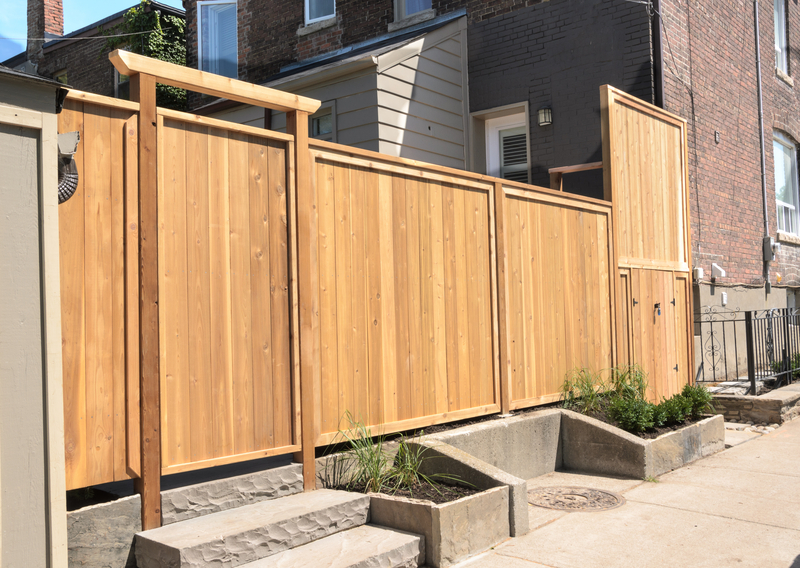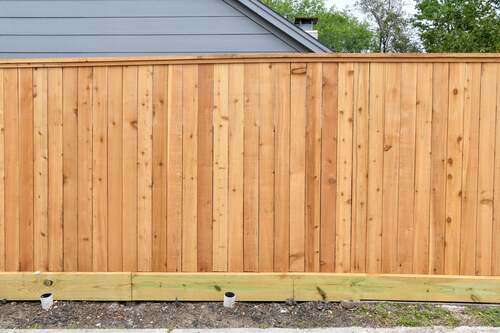Property disputes can be a nightmare, and if you’ve ever had a fence split on a property line, then you know the hassle it can be to get your neighbors to split on repair costs. Maybe your fence has suffered from wind damage or been vandalized.
Whatever the case, fence ownership is one of the most common and most frustrating property disputes.
Whose responsibility is it to repair the fence? Who is the actual owner of the fence, and which side of the fence is officially yours?
Ownership of a fence can be determined officially be a title deed, and in the event of a dispute, a property survey expert can establish direct ownership or joint ownership of the fence.
In general, if the polished side of the fence is facing your neighbors, then you are likely the owner of the fence.
There are a myriad of rules and regulations in building code that determine who has ownership and responsibility of a fence.
These rules can also vary depending on your geographic location, so if you live in the UK, for example, the rules of ownership are very different.
The rest of this article will go on to explore how you can assess whether or not you own a fence, what to do in the case of joint ownership, and how to establish legal responsibility in ownership of a fence.

Guidelines to Establish Probable Ownership
While not set in stone and still subject to legal evaluation, there are some steps you can take to figure out who the most likely owner of the fence is. The first and most practical way of doing this is just to look at your fence.
Walls and fences are usually built bordering the edge of the owner’s property, with the outer edge of the wall denoting exactly where the property ends.
As such, if you look from the inside of the owner’s side of the property, then you should be able to see the ‘bad’ side of the fence with the frames with the ‘good’ side facing towards the neighbors.
This process is typically repeated with all houses along the row such that each neighbor has one good and one inner or bad side.
This is where the common rule that you own the fence to the left of your house as you look at it from the street comes from, although it should be noted that this rule isn’t always accurate.
Obviously, the precise position of the fence isn’t the primary concern of the people who are partitioning the land, and the orientation of the fences isn’t a valid legal recourse to establish ownership.
Another quick way you can guess at whether or not you own the fence is by looking at your insurance forms and property assessment value.
Insurance and property assessment forms usually examine legal documents to determine the value of coverage needed for all your assets, so if your fence is covered by your insurance, then it’s likely that you are the owner.

Try to Establish Trust before Taking Legal Action
Before setting down a legal course of action, you should always try to establish a cordial relationship with your neighbors where possible.
Ideally, two neighbors should work together in harmony to ensure that the fence is properly maintained with no damage and that anything hung or painted on a joint fence is cleared with the other neighbor first.
Establishing a relationship of trust and joint responsibility is always the best course of action if you believe you have a joint fence or if the ownership is unclear without legal documents.
Agreeing beforehand to split repair costs and establishing a baseline for who is responsible for damages cuts out a lot of future stress and anxiety. After all, they’re your neighbor, and you have to live next to them whether you like it or not.
It’s better if you have a working trust relationship than being at odds. If possible, you can also use the aforementioned likely indicators of who owns the fence to establish a formal document declaring who owns the fence and is responsible for repairs.
Of course, sometimes, for both parties’ peace of mind, it’s better to just establish early on who owns the fence in question in a legal manner so that both parties know who is responsible for repairs and replacement of the fence.
Whoever claims responsibility for the fence will remain legally responsible.
How to Establish Ownership by Law
If you want to establish ownership by law, the quickest way is to look at your transfer, title, or conveyance deed. Uncertainty in who owns the fence can be a cause of major strife between you and your neighbor, so it’s a good idea to establish legal certainty in most cases.
If you look at the legal documentation for your house, you should be able to locate in writing whether you have ownership of the fence.
A T mark on these documents, located on the interior side of your fence, indicates that you own the fence in question, but an H mark indicates joint ownership.
Sometimes, this information can’t be found in your title, and you’ll have to do some sleuthing and find the Sellers Property Information Form, which contains information about what the previous owner believed the boundaries were for the property.
This form can also contain information about former disputes regarding the property, which can be especially useful if there was already a resolved dispute about the ownership of the fence, as well as any former modifications to the property.
It may also contain information about who paid for repairs in the past. Legally speaking, this can be a good way to establish proper ownership of a fence. You can also contact your local zoning board to determine what the local zoning laws are in your area.
These laws may have information regarding who owns the fence and can be used to mount a legal defense of ownership.
What Does Joint Ownership of a Fence Mean?
Quite simply, joint ownership of a fence means that you and your neighbor are both responsible for maintaining, repairing, and replacing the fence. If you should choose to change the fence entirely, a new one must be agreed upon by both parties.
Any changes to the fence that take place on your side― painting, fixtures, modifications― can only happen with your say so. If changes on your side of the fence are made without your approval, you have the right to take legal action against your neighbor.
Remember that they can do whatever they want on their side, as long as it doesn’t impact yours.
In the event of full replacement, you or your neighbor must submit to the other joint owner a 30-day notice of intended changes.
If either party disagrees with the replacement of the fence, then it cannot be changed; however, if your neighbor serves you a 30-day notice and you fail to respond, your neighbor can make you legally obligated to pay for half of the replacement.
If your neighbor makes changes to your side of the fence fence without your permission, you have the right to sue them, call the police, or get a mediator involved.
Of course, dragging your neighbor to court isn’t usually the best course of action, and while it can be annoying to wake up to something unwanted hanging on your fence or holes drilled through, talking with your neighbor first is always wise.
Oftentimes, they’re simply not thinking about how it might affect you. Careless, perhaps, but not malicious. Asking them to undo the changes or make repairs is always the first courtesy you should offer your neighbor.
Court fees can hike up really quickly, and it’s always best to try to resolve the situation peaceably first.

What Can You Do If Your Neighbor Owns the Fence?
Keep in mind that if the fence is on your neighbor’s property (even by a hair), then you have no say in what they do with it.
They are free to leave it in a state of complete disrepair or remove it entirely if they feel like it. Of course, you can always politely ask them to make a repair or let you know if they plan to alter the fence at all.
If they are planning on removing the fence, you can simply construct a fence on your property so that you don’t have to look at your neighbor’s yard.
Other Ways to Handle a Dispute
As part of a community, if your neighbor insists on altering or adding things to a fence that legally belongs to you, a wise first resort is to write them a letter listing your complaints.
With any luck, they will recognize that they are in error and agree to stop doing whatever is bothering you.
If they remain resistant, contact your HOA to seek their advice.
Local codes are your friend when the law is on your side, and the HOA will likely serve as a mediator to resolve the situation peacefully and can determine whether a law has been violated. Hiring a legal mediator is also a good recourse in the event of damage to the fence.
Install cameras that overlook your property to confirm who’s trespassing and consider adding a no trespassing sign. It may seem rude to treat your neighbors like this, but if you want solid evidence in court, you’ll need to have a camera.
If you’re able to prove that the fence is yours, then you can legally force your neighbor to pay for necessary repairs to a damaged fence. If there are any attachments on your fence, you will be able to sue or have the town fine them.
Depending on your local zoning laws, you may be able to remove the attachments yourself.
If the ownership of the fence is in question, the best way to resolve the issue is to agree upon hiring a property surveyor, who will be able to definitively say who has legal ownership of the fence.
Remember that if you have claimed ownership of the fence, then you have no legal grounds to request that they cover the cost of any repairs or replacement unless they were the ones who damaged or altered your fence.

Conclusion
In short, cordiality is always the best way to start. Establishing a mutually beneficial relationship with your neighbor and determining ownership is the best way to avoid future headaches of who’s going to have to fork out money on the fence.
Offering respect and decency will also go in your favor if a dispute does arise. To do a quick check on who likely owns the fence, you can look and see whether the ‘good’ side faces your neighbors.
If so, then the fence probably belongs to you, although the orientation of the fence isn’t legal grounds for claiming ownership. To establish legal ownership, you’ll need to dig through your title or conveyance papers to find a title of ownership on the fence.
You’re on the lookout for a T on your side of the fence to indicate that you own it. If you find an H instead, then the fence is jointly owned, and the two of you must split the cost of repairs evenly.
If your neighbor refuses to pay, you have legal recourse to bring up the issue with your HOA, but you should always aim to handle difficult situations with as much tact and openness as possible.
Just as you have the right to tear down a fence if it belongs to you, so does your neighbor if it belongs to them.
While you may be able to get your neighbor in trouble with the HOA in your area if they’re neglecting repair on their fence, you have no legal say in whether or not they have to repair the fence.
Hopefully, by establishing and agreeing upon legal ownership of a property ahead of time, you can avoid any unpleasant property disputes from arising in the future.







